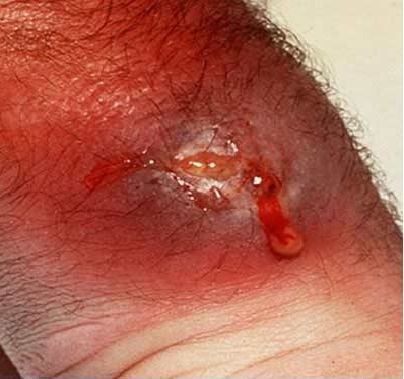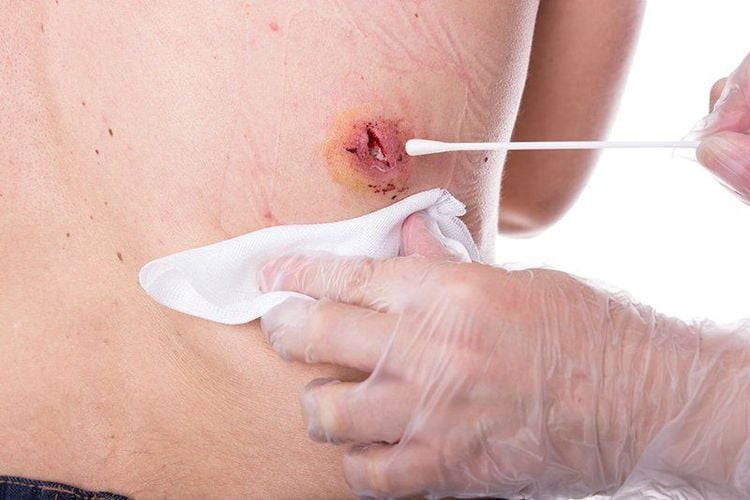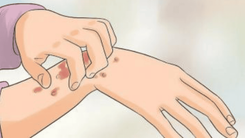When an open wound on the body leaks yellow fluid, it can be concerning. But what exactly is this yellow fluid, and how should you handle a wound that oozes it?
1. Why does a wound ooze yellow fluid?
Yellow fluid may leak from open wounds, often caused by accidents or deep cuts that expose tissue. These wounds lose their protective barrier, making them vulnerable to bacterial invasion.
The yellow fluid in these wounds can be classified into two types, differing not only in color but also in their implications.
1.1 Clear yellow fluid
This is physiological discharge from the body, specifically plasma. This type of fluid is harmless and serves a protective role for the wound, cooling it and shielding it from external irritants.
Clear yellow fluid usually appears 3–7 days after injury and helps protect and heal the wound if managed properly.
During this phase, the edges of the wound may show pink or reddish marks accompanied by itching, signaling the growth of new skin.
1.2 Cloudy yellow fluid
Cloudy yellow fluid, along with white pus and a bad smell, often signals infection.
This condition can worsen if untreated, leading to increased itching, swelling, redness, pain, or even tissue necrosis.
2. Common causes of wound infection
Open wounds are highly susceptible to infection due to various factors, including:
- Using soap to clean the wound: Many people mistakenly use regular soap to clean wounds, which can irritate the area and slow the healing process.
- Dirt contamination: Wounds sustained in dirty environments (e.g., on asphalt or in polluted air) are prone to infection. Dirt can be hard to remove without vigorous scrubbing, which risks further harm.
- Lack of protective covering: While wounds shouldn't be overly sealed, leaving them uncovered entirely can invite bacterial invasion. A moist but protected environment is vital for healing.
- Metal-related injuries: Deep wounds from rusty metal objects require immediate medical attention due to a high risk of tetanus. These cases often necessitate professional cleaning and, if needed, vaccination

3. How to handle a wound that oozes yellow fluid
External wounds are often minor and usually not life-threatening. However, if the wound persists or becomes infected, it can lead to more serious complications, affecting daily activities and potentially causing additional health problems.
To speed up wound healing, proper nutrition plays a crucial role in the recovery process. Here are some important steps to take when handling an open wound to prevent infection:
- Step 1 - Wash your hands
Before touching any wound, especially an open one, the first step is to wash your hands thoroughly with soap or an antiseptic solution. Since your hands will come into direct contact with the wound, cleaning them minimizes the risk of infection. If possible, wear disposable medical gloves when handling the wound for additional safety. - Step 2 - Stop the bleeding
An open wound means the protective outer layer of skin is damaged, causing blood to flow out. Depending on the size and nature of the wound, the amount of bleeding can vary. Apply firm pressure with sterile cotton or gauze to stop the bleeding. If no sterile materials are available, you can press on the wound with your clean hands. Step 3 - Clean the wound
Once the bleeding stops or yellow fluid starts to ooze, it’s crucial to clean the wound properly. Use saline solution or a stronger antiseptic to disinfect the wound. Avoid using alcohol or hydrogen peroxide as they may irritate the tissue and slow healing.When cleaning, make sure to also disinfect the area surrounding the wound. Though cleaning an open wound can be painful, it is essential to ensure thorough disinfection to minimize the risk of infection.
- Step 4 - Apply antibiotics
For large, deep wounds or if you notice yellow, cloudy fluid (a sign of infection), antibiotics may be necessary. The type of antibiotic depends on the wound and the patient’s overall condition.
Consult a healthcare professional to determine the most suitable treatment. Antibiotics may be in the form of topical powders, liquid solutions, or oral medications.

- Step 5 - Bandage the wound
After cleaning and disinfecting, bandage the wound immediately to prevent further contamination. Ensure that the bandage or dressing is new, clean, and sterile, as it will remain in prolonged contact with the wound. Avoid wrapping the bandage too tightly or too loosely, as both can hinder the healing process. Regularly change the dressing to keep the wound clean and protected. - Step 6 - Monitor the wound
Check the wound at least once daily, ideally every 4 hours, to monitor its condition. This step ensures you regularly replace the dressing and assess the wound’s progress.
There are two possible outcomes:
- Positive progress: The wound dries up, new skin (granulation tissue) forms, and the wound heals effectively.
- Negative progress: The wound worsens, with swelling, redness, pus, yellow cloudy discharge, and increasing pain.
See a doctor right away if the wound worsens or shows signs of infection. Ignoring a small wound could lead to severe complications such as tissue necrosis, fever, or general fatigue.
Please dial HOTLINE for more information or register for an appointment HERE. Download MyVinmec app to make appointments faster and to manage your bookings easily.







